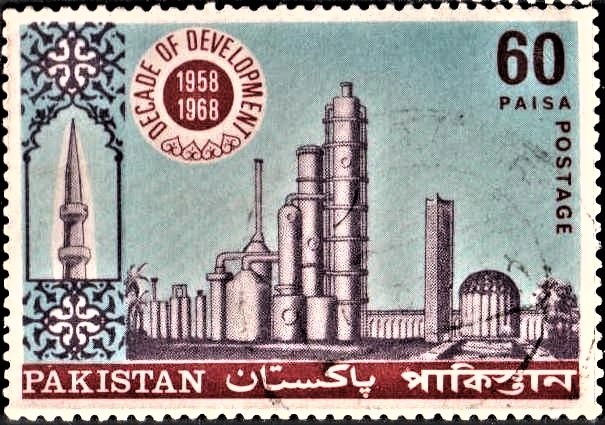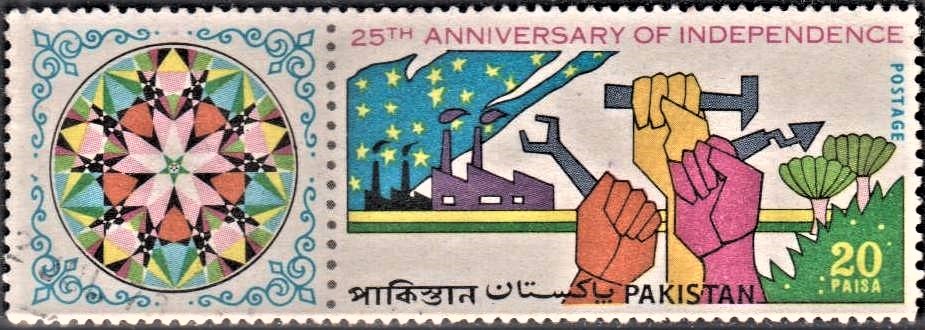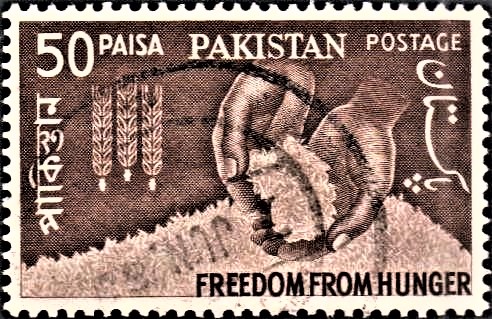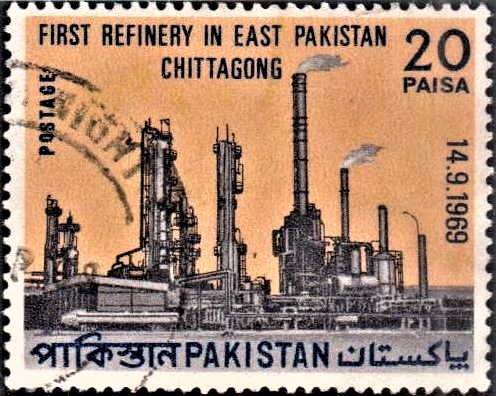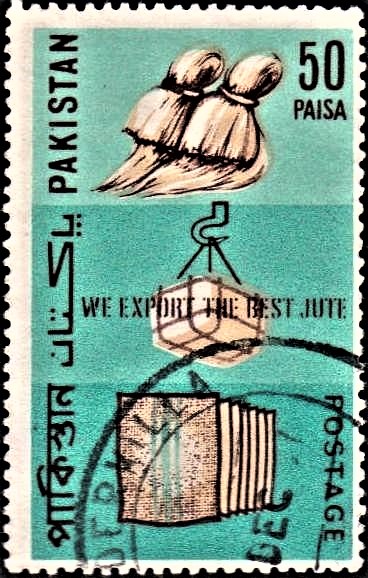
Major Exports of Pakistan 1967
A set of three commemorative postage stamps to publicize Major Export Products of Pakistan :
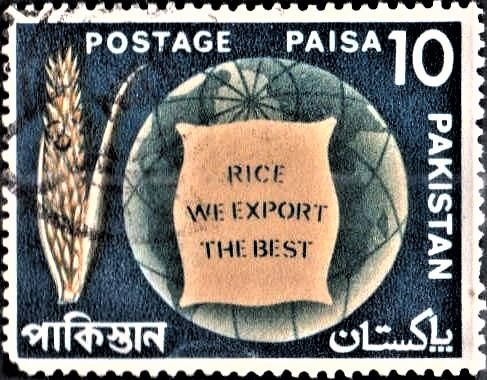

 Issued by Pakistan
Issued by Pakistan
Issued on Sep 26, 1967
Issued for : To highlight the major exports of Pakistan, comprising Jute and Jute Products, Cotton and Cotton Textiles, and Rice, the Pakistan Post Office is issuing a set of three stamps in the denominations of 50, 15 and 10 paisa on September 26, 1967.
Designs :
10 Paisa : The design is horizontal. Against a dark blue background a globe is shown behind a rice bag. The bag is in yellow with a caption “RICE WE EXPORT THE BEST” in stencilled lettering printed in Blue. At the left side of globe appears an ear of rice. The wordings “POSTAGE” and “PAISA 10” appear in reverse at the top of the stamp. The word “PAKISTAN” in English, Bengali and Urdu appears in reverse on the right hand side of stamp, in the bottom left and right corners respectively.
15 Paisa : The format of the stamp is rectangular. It is horizontally sub-divided into three rectangles of equal sizes with differing shades of orange. In the top rectangle is shown a cotton plant, a caption “RAW COTTON” is printed to the left of the plant. In the middle rectangle of darker orange two spindles of cotton yarn are shown, a caption “COTTON YARN” is printed at the right side in green. In the lower rectangle of darkest orange, cotton fabrics are represented by two patterns of printed cloth, a caption “COTTON TEXTILE” is printed at left in green. The denomination “15 Paisa” appears in the top right corner of the stamps. “POSTAGE” printed vertically appears on the right in the bottom rectangle. “PAKISTAN” in Bengali, Urdu and English printed in green appears vertically in each rectangle reading from bottom to top.
50 Paisa : The format of the stamp is rectangular. It is horizontally sub-divided into three rectangles of equal sizes with differing shades of Green. In the top rectangle is shown two bundles of raw jute. In the middle rectangle of darker green a jute bale being lifted by a crane is shown. A caption “WE EXPORT THE BEST JUTE” is printed in brown in the centre. In the lower rectangle of darkest green manufactured jute bags are shown. The denomination “50 Paisa” appears in the top right corner of the stamp. “POSTAGE” printed vertically appears on the right in the bottom rectangle. “PAKISTAN” in Bengali, Urdu and English printed in brown appears vertically in each rectangle reading from bottom to top.
Type : Stamps, Postal Used
Denomination : 10, 15 & 50 Paisa
Colour :
10 Paisa – Yellow & blue
15 Paisa – Green, orange & yellow
50 Paisa – Green, dark brown & yellow
Size of stamps :
10 Paisa – 40.5 x 31.5 mm
15 Paisa – 48 x 30.5 mm
50 Paisa – 48 x 30.5 mm
Size of Prints :
10 Paisa – 37.5 x 28.5 mm
15 Paisa – 45 x 27.5 mm
50 Paisa – 45 x 27.5 mm
Perforation Gauge : 13 x 13½ (C)
Quantity Printed : 15,00,000 each
Number of stamps in each sheet : 50
Process of Printing : Photogravure
Printers : The Pakistan Security Printing Corpn. Ltd., Karachi
About :
- Jute and Jute Products
- Jute is the vital cash-crop and the single biggest foreign exchange earner for Pakistan. Industrial development of Pakistan had been possible mainly due to the foreign exchange earned by jute. Apart from its lion’s share in foreign exchange earnings, its cultivation, marketing and manufacturing provide employment to lakhs of people in East Pakistan. It is estimated that more than 50 lakh families are directly concerned with its cultivation and thousands of people are employed in jute trade and industries. Jute occupies the top most position in the world for its use in the preparation of packing materials. Pakistan alone grows about 45 percent of the World Jute produce. Her jute production is further being increased by 20% to 25% (i.e. 80 lakh bales) during the Third Plan period. During the year 1966-67, Pakistan earned foreign exchange amounting to Rs. 90.91 crores by the export of 35.40 lakh bales of raw jute.
- At the time of independence, out of 108 jute mills in undivided India, not even a single mill fell in Pakistan’s share. The Government of Pakistan were fully aware of this situation and took the earliest possible steps to fill the void between Pakistan’s production of large quantity of raw jute and its lack of jute industry. Though the jute industry in this country was first established in 1950 and started production in 1951, export of jute manufactures could only be started from 1955. The industry has established a sustained and increasing demand for its products in almost all countries of the world where jute goods are consumed. The extent of its progress may be gauged from the fact that production has increased from 130,209 tons in 1955-56 to 403,711 tons in 1966-67. Exports this year (1966-67) totalled 352,140 tons.
- The industry is not only manufacturing the traditional packaging materials, hessian and sacking, but is also producing specialised fabrics such as carpet backing cloth, woven carpets, cotton bagging, webbings, laminated bags etc.
- Starting with 312 looms in operation in 1951, the jute industry is at present working with around 16,000 looms. The expansion of the industry is progressing at a satisfactory rate and it is hoped that by 1970, the Third Plan target of 28,000 flat looms and 2,000 broad looms would have been reached.
- Cotton and Cotton Textiles
- Next to jute, cotton is the second largest foreign exchange earner in the group of primary commodities. It is grown in West Pakistan, though a small quantity of Comilla cotton is also produced in East Pakistan. The crop meets the country’s full requirements of cotton cloth and provides about 1 lakh tons of cotton-seed oil and highly nutritious feed for animals in the form of seed as well as oil cakes.
- Cotton has been grown in Pakistan since times immemorial. In fact, it is now fairly certain that cotton was spun for the first time in the history of mankind in the Indus Valley in West Pakistan. The art of spinning and weaving reached a high degree of excellence in olden times in East Pakistan, and the Dacca muslins were, at one time, world famous. Thus, although Pakistan is a new State, its deep association with cotton is a heritage from very ancient times. Cotton in Pakistan is grown mainly in a well defined belt, running north and south in the former Punjab, Sind and Bahawalpur. Both desi (indigenous varieties of G. arboreum) and acclimatised American (G. hirsutum) are grown. As regards East Pakistan, the rough and short staple variety of cotton known as “Comilla” is grown on about 37,000 acres in that Province.
- The production of cotton in Pakistan has increased from 20.76 lakh bales in 1962-63 to 25.73 lakh bales in 1966-67. In 1967-68, the production is likely to touch the level of 28.00 lakh bales. The Pakistan American cottons constitute the bulk of the Pakistan cotton crop. Their staple characteristics fall near the middle of world cotton, i.e. 7/8” to 1-1/8”. A distinctive feature of these cottons is their relatively high tensile strength and maturity.
- The value of exports of raw cotton from Pakistan during 1964-65 was 28.70 crores of Rupees; during 1965-66, 27.84 crores of Rupees and during 1966-67 (July-May) 25.58 crores of Rupees. The export is likely to increase with the increase in production during the third five year plan period. The major buyers of Pakistan’s raw cotton are Hongkong, Mainland China and Japan and in the West, the traditional buyers of Pakistan raw cotton are U.K., France, Italy, Netherlands etc. U.S.S.R. and other Socialist countries are also buying cotton from Pakistan under barter agreements.
- Of the major industries in the country, the cotton textiles industry is the single largest industry providing employment to a large number of persons. Made of superior cotton produced indigenously, the textile fabrics of Pakistan are distinguished for their lustrous colours, compact texture and rich combination of exquisitely done floral and geometrical designs.
- Pakistan produces nearly 550 million lbs. of yarn and 750 million yards of cotton cloth of which 80 million lbs. of yarn and 200 million yards of cloth is annually exported to U.S.A., and U.K. (in spite of quota restrictions) and several countries in Far East and the Middle East. Due to heavy demand in the international market in addition to increasing domestic demand, the country is progressively expanding her textile production. By the close of the Third Five Year Plan (1965-70), yarn production is likely to reach the colossal figure of 620 million lbs. and yardage of cloth to 1400 million. There are over 65 Textile Mills in the country at present.
- Famous for her fine Dacca muslin and sarees, baftah fabrics, wax cloth, bundani (tie and dye), ajrack (block print) and Baluch mirror work, Pakistan has a very wide variety of artistically hand-spun and hand-woven fabrics in highly attractive patterns and designs. Visitors to Pakistan from every part of the world have been taking home Pakistan’s gaily patterned hand-woven fabrics as souvenirs for their friends and families. A substantial portion of these specialities of Pakistani artisans and craftsmen find their way to different parts of the world for a long wear and/or decorative purposes.
- Rice
- Gourmets all over the world know that, for the discriminating, no long grain white rice is as good as ‘Basmati’. ‘Basmati’ is truly unique. This rice is grown on the fertile alluvial soil of the submontane districts of the Punjab in West Pakistan, watered by the cool streams of the Himalayas. The rich fertile soil, the fresh waters and the ideal balance of heat and moisture of the Valley of Five Rivers gives ‘Basmati’ its fine form, its special fragrance and its exquisite flavour and softness. These were the qualities which made ‘Basmati’ the favourite of the Empress Nurjehan, the queen of queens, the light of the eyes of the Moghul Emperor Jehangir.
- Of the superior varieties of rice ‘Basmati’ continues more than 95%. This special quality of rice has become very popular in the foreign markets and fetches a very high price in foreign exchange. It has during the past few years become one of the very important foreign exchange earners in the country. This rice is produced mainly in four districts of West Pakistan namely Sheikhupura, Gujranwala, Gujrat and Sialkot.The ‘Basmati’ grain has a distinguished look. It is sword-like, faintly curved at the tips. The body of the grain is slender and has a polished look – this is of course due to its healthy white colour and translucent quality. ‘Basmati’ has a distinct fragrance about – both when raw and when cooked. On cooking, the grains elongate to about twice their original size and remain completely separate from each other. Cooked grains are characteristically curved and do not burst. Of the large number of Pakistani dishes, three acknowledged favourites are Pakistani ‘Biryani’; Pakistani ‘Zarda’ (Dessert) and Pakistani ‘Kheer’ (Dessert).
- ‘Basmati’ rice of West Pakistan has, of late, become an important foreign exchange earner for Pakistan. Starting from 25,000 tons valued at Rs. 1.02 crores in 1958-59, the export of superior rice (of which Basmati constitutes the bulk) has gone upto 170,000 tons valued at about 17 crores of rupees in 1966-67. Demand from the foreign buyers is increasing and we can almost double the exports.
- With the compliments of the Director-General, Pakistan Post Office, Karachi.


